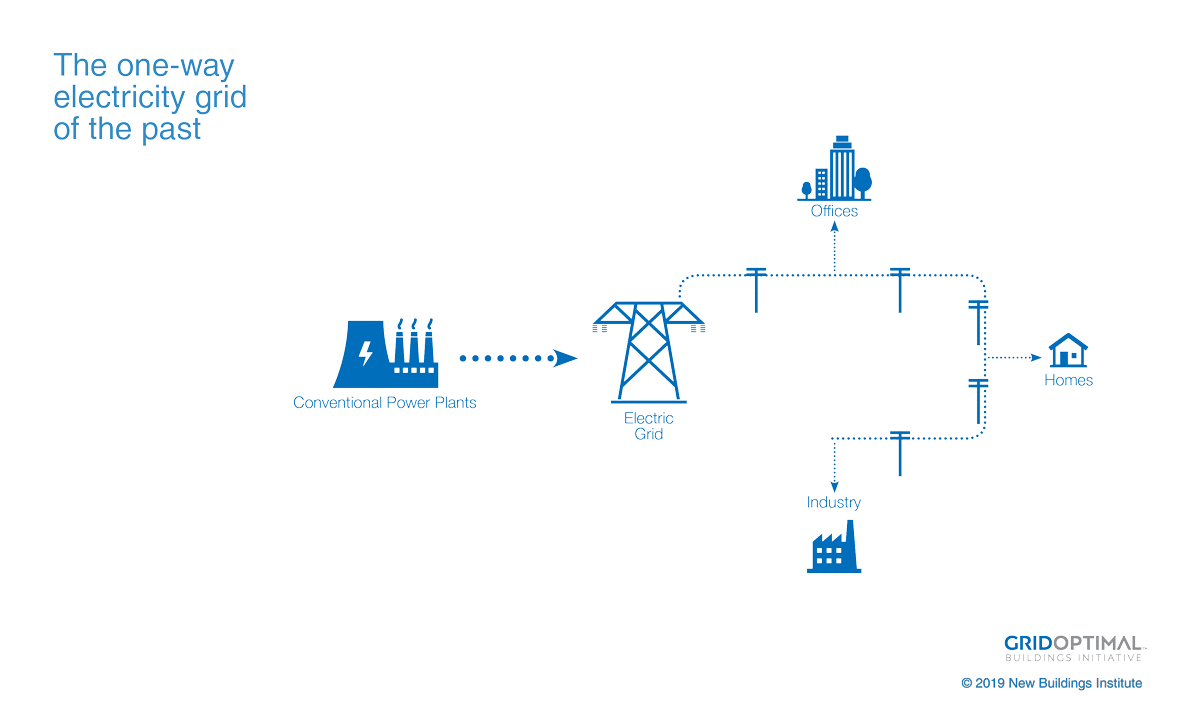The GridOptimal Buildings Initiative
Paper / October 26, 2021 / Building Innovation
The role of buildings, renewable energy, and energy storage in the utility industry is changing. New near-term solutions are needed to address today’s challenges and capitalize on opportunities for market transformation. New Buildings Institute, in partnership with the U.S. Green Building Council (USGBC), is leading a national coalition committed to better integrating buildings into utility grid management strategies.
This project, called the GridOptimal® Buildings Initiative, has developed new metrics by which building features and operating characteristics that support more effective grid operation can be measured and quantified. Learn more in our summary blog and detailed white paper. These metrics are at the core of the new GridOptimal Buildings Pilot LEED credit.
This will support the least-cost decarbonization of the grid through better integration of both distributed energy resources (DER) and utility-scale wind and solar energy. The animated graphic below shows how the GridOptimal Buildings Initiative can play an important role in catalyzing the transformation of buildings and the grid.
By creating a standardized set of metrics that define a building’s contribution to the relevant utility grid scale—the building’s operational performance as a grid asset—many doors open. Utilities may incentivize grid-sensitive design. Government agencies may include the metrics in their procurement requirements or in their climate policies. Designers and building owners can consider these impacts in projects in sensible, straightforward ways. Building codes and standards can encourage and require the adoption of these solutions. Together, these forces will encourage market actors to develop new solutions for current and emerging utility grid challenges.
We are currently accepting pilot projects. If you are interested in participating as a partner or as a pilot project, please contact Alexi Miller.
The Problem
Building occupants expect reliable, high-quality electricity on demand, regardless of what occurs behind the meter to meet that demand. For more than a century, the power grid has relied on one-way energy flows from large, centralized power plants, usually powered by fossil fuels. Today, new policies, such as carbon emissions reduction targets and new technology (including vastly cheaper renewable energy and energy storage) are forcing grid operators to seek a new paradigm. There has been, and will continue to be, huge distributed energy resouce (DER) growth in neighborhoods around the country. Bridging the gap between yesterday’s centralized, fossil-powered grid and tomorrow’s DER-rich, low-carbon grid will require new thinking and new strategies.
 Building-scale strategies are a critical component of the transformation of the power grid and the decarbonization of our society. However, at the building-level, there is a real lack of knowledge and incentive to encourage grid-friendly design and operation, even though buildings built today may interact with the grid for a century or more. It is illuminating to consider the impacts of individual buildings on the grid through the lens of a building’s “grid citizenship.” A good grid citizen is a building that contributes to, rather than detracts from, the reliable, safe, and affordable operation of the grid.
Building-scale strategies are a critical component of the transformation of the power grid and the decarbonization of our society. However, at the building-level, there is a real lack of knowledge and incentive to encourage grid-friendly design and operation, even though buildings built today may interact with the grid for a century or more. It is illuminating to consider the impacts of individual buildings on the grid through the lens of a building’s “grid citizenship.” A good grid citizen is a building that contributes to, rather than detracts from, the reliable, safe, and affordable operation of the grid.
Across North America, there are no metrics in wide use today that define building-level grid citizenship or consistently rate the quality of building-grid interactions. Current thinking on the topic is fragmented and different players are using different language to discuss the topic from a variety of perspectives.
The Solution
NBI and the USGBC have developed a collaborative and inclusive process to create standards and tools to meet the new challenges of supporting a low carbon grid. The initiative aims to provide standards, tools, and guidance to improve building-grid interactions in the built environment by empowering owners, architects, and engineers with dedicated metrics, strategies, and pilot projects. The initiative builds on NBI’s proven leadership on this issue, and on the market reach of the Leadership in Energy and Environmental Design (LEED) green building rating system to develop and deploy these new metrics across the market.
GridOptimal metrics and the strategies underlying this work will play a major role in bridging the gap in knowledge, understanding, and priorities between the two sides of the grid: operators and consumers. The initiative will support carbon emissions reduction policy goals while ensuring that buildings enhance the affordability, reliability, and safety of the grid today and in the future.
Current focus areas for GridOptimal include advancing grid optimization utility and LEED programs, supporting emerging technology field validations for flexible load management, providing more market-oriented guidance, driving code and policy advancement, and identifying and addressing gaps and barriers in industry tools and practices.
GridOptimal Building Design and Operations Fact Sheets
These easy-to-understand fact sheets provide key context and recommend selected high-impact building design and operations strategies for a variety of building types and U.S. regions.
| Optimizing Building Grid Integration in Building Types | Optimizing Building Grid Integration in U.S. Regions |
| Office Buildings | Southwest United States |
| Education Buildings | Northwest United States |
| Multifamily Buildings | Texas and the Southern Great Plains |
| Single Family Homes | Northern Great Plains |
| Retail Buildings | Midwest and Mid-Atlantic |
| Warehouses | Northeast United States |
| Southeast United States |
GridOptimal Buildings LEED Pilot Credit
Project teams can now receive up to three points for improving building-grid optimization in the LEED-BD&C v4 and v4.1 rating systems. GridOptimal metrics are used to define project performance and award points. LEED project teams use the free GridOptimal Pilot ACP calculator to demonstrate performance, but other project teams will likely also find the tool’s analysis and chart capabilities useful.
GridOptimal Metrics Calculator
This spreadsheet enables designers, building owners, consultants, and others to quantify a building’s operational performance as a grid asset by calculating the building’s GridOptimal metric scores, including estimates of demand flexibility. Users can input information including their building’s location and load shape and will see GridOptimal metric scores. Automated graphs showing building peak demand shapes, grid load shapes, and grid carbon emissions are also available.
GridOptimal Measure Impact Analysis Tool
NBI built on a large body of GridOptimal research and pilot projects to build an interactive tool that allows users to compare the impacts of a variety of energy efficiency and demand flexibility strategies across a wide range of U.S. climate/grid zones and building types.
GridOptimal Utility Program Guidance
This memo recommends specific steps and options for utility programs seeking to improve existing energy efficiency and demand response programs and proposes alternate program frameworks for consideration.
Learn More
Webinar 1: The GridOptimal Buildings Initiative Phase 1: Metrics, Modeling, and Momentum
Webinar 2: GridOptimal: Outcomes and Lessons Learned from the First Pilot Project
LEED GridOptimal Buildings Pilot Alternative Compliance Path
GridOptimal Year 1 Outcomes Summary June 2019
GridOptimal Year 2 Outcomes Summary July 2020
GridOptimal Year 3 Outcomes Summary December 2021
GridOptimal Intro Presentation
Grid-Interactive Building Project Roundup (Getting to Zero Forum 2023 presentation)
The California Roadmap to a Carbon Free Future for the Built Environment, Published by Meeting of the Minds
Show Me the Money, Published by GreenBiz
“GridOptimal” Buildings Can Smooth Transition to Renewables, published by BuildingGreen
Questions? Contact Alexi Miller, PE, LEED-AP+ Associate Technical Director, [email protected]



